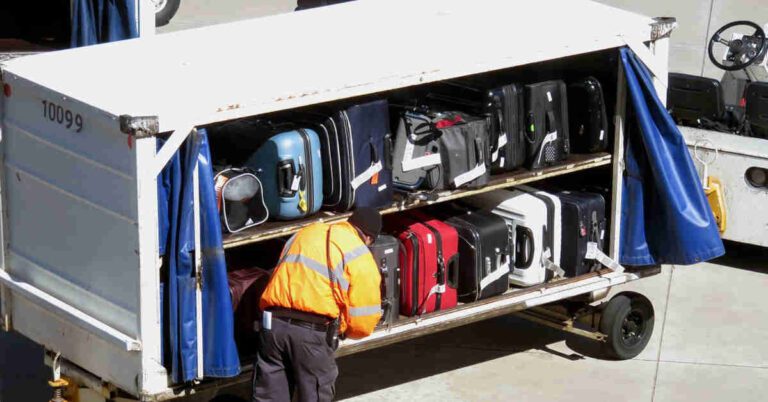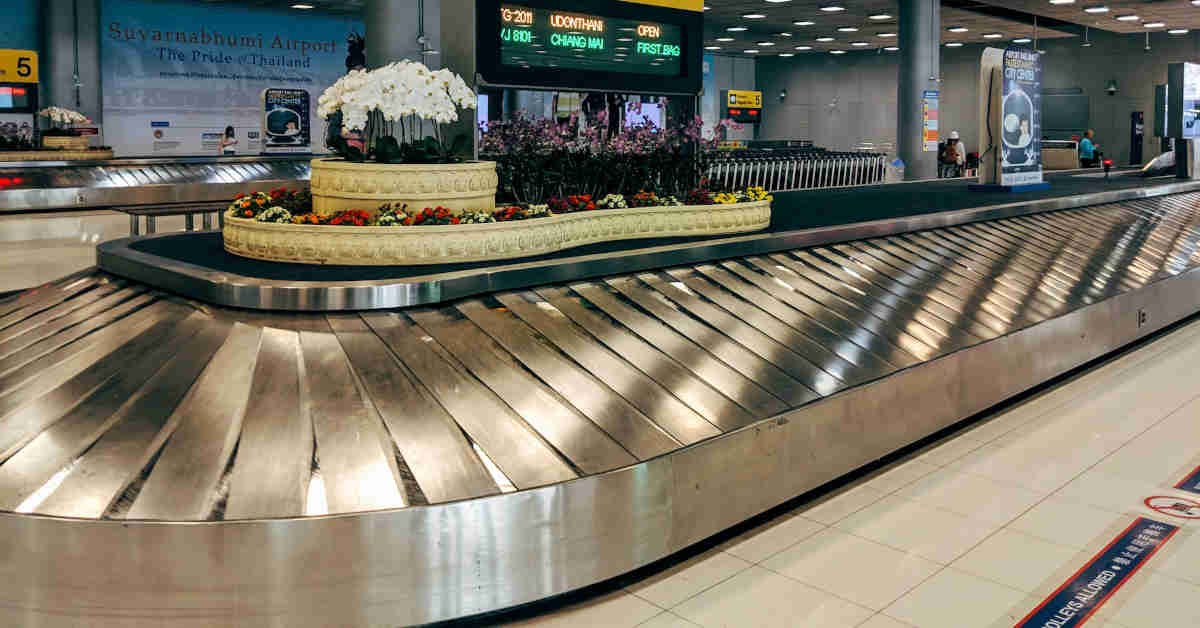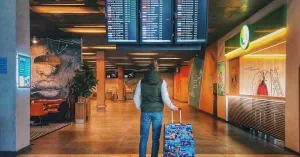In this post we are going to discuss what checked baggage is and what to expect when traveling with them. We will cover the allowances and fees that you should expect as well as ways to avoid having to pay for fees. Also, we will cover items commonly prohibited in checked bags.
What is Checked Baggage?
Checked baggage refers to any luggage that is taken from you at the airport and placed in the cargo hold of the plane. This is in contrast to carry-on baggage, which you bring with you onto the plane and store in the overhead compartments or under your seat.
Checked baggage is typically larger and heavier than carry-on luggage and can include items such as clothing, shoes, toiletries, and other personal belongings.
Why Check Your Baggage?
Many airlines allow passengers to bring a certain amount of carry-on baggage on board, but the space is limited. Checked baggage allows you to bring larger items, such as clothing, shoes, and toiletries, which may not fit in your carry-on luggage.
Also, if you’re traveling for an extended period, it may be necessary to check your luggage to accommodate all of your belongings.
Airline Checked Baggage Policies
Every airline has its own baggage policy that places limits on a checked bag’s size and weight. These limits can vary depending on the airline, flight route, fare class, and frequent flyer status.
To avoid excess baggage costs, it’s always a good idea to check with your airline before you fly so that you’re aware of your checked baggage allowance.
What can be confusing is when you are traveling on an itinerary with connecting flights, multiple airlines, or separate bookings. If each flight segment has a different checked baggage policy, which one applies to you?
The rule of thumb is that the baggage allowance applies for an entire booking. Correspondingly, your checked baggage allowance will be on your e-ticket for each booking.
With each booking, your checked baggage is usually transferred by the airline to your next flight. There are exceptions to this rule, so it’s always best to confirm with the airline.
Domestic Flights and Checked Baggage Policies
With very few exceptions, checked baggage is no longer complimentary with economy tickets on domestic airlines. You will have to pay a fee to check any bags.
If you bought a premium cabin fare, have frequent-flyer status, or a qualifying airline-branded credit card, you may be eligible to check one or more bags for free.
Southwest Airlines is the only domestic carrier that gives two free checked bags as standard for all passengers.
International Flights and Checked Baggage Policies
For some international flights, complimentary checked baggage is included with the ticket price. Basic economy fares generally do not include a free baggage allowance.
Size Limits for Checked Baggage
Virtually all airlines enforce a size limit on standard checked bags of 62 linear inches (157 centimeters). Allegiant Air has a size limit of 80 linear inches (203 centimeters) for checked bags.
This measurement is calculated by measuring your bag’s outside length, width, and height, then adding these measurements together.
You need to include any protruding wheels, handles, or straps when taking your measurements. An exception to this is Southwest Airlines – they don’t include the wheels when measuring your bags.
Oversized Checked Bags
If your checked bag is larger than 62 linear inches, you will be subject to an oversize fee. Oversize bags can usually be up to 80 linear inches (203 centimeters) or 126 linear inches (320 centimeters), depending on the airline. Airlines don’t accept checked bags beyond this size.
Some airlines make exceptions to their absolute size limit for special items such as sports equipment or musical instruments.
Weight Limits for Checked Baggage
This is where we see segmentation in the airline carrier market. Most airlines allow each standard checked bag to weigh up to 50 pounds (23 kilograms). Some low-cost carriers impose a 40-pound (18.1 kilogram) limit.
In specific circumstances, the checked baggage weight limit for standard bags may be greater, including:
- Specific international routes
- Traveling in a premium cabin
- Having elite frequent-flyer status with an airline
- Active-duty military personnel traveling on orders.
Overweight Checked Bags
If your checked bag is heavier than the airline’s standard bag weight limit, you will have to pay a fee to check in your overweight bag.
Airlines normally have two overweight checked bag categories:
- 51 to 70 pounds (23 to 32 kilograms)
- 71 to 100 pounds (32 to 45 kilograms)
Airlines usually won’t accept checked bags weighing more than 100 pounds.
Checked Baggage Fees
Baggage fees are charges that airlines impose on passengers for checking in their luggage. These fees vary depending on the airline, route, and type of fare.
Most airlines have an escalating fee structure for checked baggage, based on how many bags you check in. You should expect to pay $30 for your first bag, and $40 for your second. Beyond that, charges jump up drastically – anywhere from $100 to $200 per extra bag. If your bags are also oversize ($100 – $200) and/or overweight ($100 – $200), you can see that your extra bags become prohibitively expensive.
These fees are usually cumulative, meaning that you could be looking at paying up to $600 for an extra oversize and overweight bag!
Bag fees tend to be cheaper the earlier you pay for them – the cheapest being at your initial booking. This is especially common with low-cost carriers.
Hot Tip: American Airlines apply the same fees no matter when you pay for your bags – paying for them at the airport is no more expensive than pre-purchasing them. Considering that the fees are non-refundable, it’s always best to pay for your checked bag fees at the airport on the day of your flight, in case you reschedule or cancel your flight.
Dynamic Baggage Fees
A widespread practice among low-cost carriers is applying dynamic pricing to their checked bag fees. What this means is that your checked bag fees depend on where and when you are traveling.
These airlines have a “baggage tool” where you enter your flight details to reveal what your bag charges will be.
This lack of transparency can be frustrating when planning a trip, but I suspect that the airline would say that they do this to offer the cheapest fees possible.
Avoiding Checked Bag Fees
There are ways that you can avoid paying for at least some of your bags:
- Traveling in a premium cabin
- Holding elite loyalty status
- Being a card member of an eligible airline-branded credit card
- Active-duty military personnel traveling on orders.
Mobility equipment and assistive devices such as wheelchairs, crutches, infant strollers, and child car seats are exempt from checked bag fees and do not affect your baggage allowance.
Checked Baggage Restrictions
Although not as restrictive as carry-on baggage, there are item types which you cannot pack in checked baggage.
A general rule is that if an item is hazardous, flammable, or explosive, it’s prohibited. For an exhaustive list of what’s not allowed in checked bags, you can refer to TSA’s What Can I Bring.
Items which are prohibited include:
- Explosives (such as fireworks and flares)
- Flammable items (such as gasoline and lighter fluid)
- Compressed gases (such as butane and propane)
- Firearms and ammunition
- Lithium batteries
It’s important to note that airlines have the final say in what items are allowed or prohibited on their flights. Some airlines may have extra restrictions or limitations, so it’s best to check with your airline before packing.
Packing Checked Baggage
What to Pack in Checked Baggage
Items that are allowed in checked baggage include:
- Clothing and shoes
- Books, magazines, and electronics
- Toiletries and personal hygiene items
- Sporting equipment, such as golf clubs and skis
It is recommended to pack any valuable or fragile items in your carry-on luggage, as these items are not covered by the airline’s liability for lost or damaged baggage.
How to Pack Checked Baggage
Packing your checked baggage properly is crucial to ensure that your items arrive at your destination in good condition. Here are some tips for packing your checked baggage:
Choose the Right Suitcase
Invest in a durable suitcase that can withstand the wear and tear of travel. Choose a suitcase that is the right size and weight for your needs and that has plenty of pockets and compartments for easy organization.
Use Packing Cubes
Packing cubes are an excellent way to keep your items organized and separated in your suitcase. They are also great for maximizing space and preventing wrinkling.
Pack Heavier Items First
When packing your suitcase, start with the heavier items first, such as shoes and toiletries. This will help to distribute the weight evenly and prevent any shifting during transit.
Roll Your Clothes
Rolling your clothes instead of folding them can help to maximize space and prevent wrinkles.
Use Bubble Wrap
If you are packing fragile items, such as electronics or glassware, be sure to use bubble wrap or other protective materials to prevent damage.
Label Your Baggage
Attach a luggage tag with your name and phone number to each piece of checked baggage. This will help airline staff locate and return your luggage in case it gets lost.
Lock Your Bag
Finally, you can use a lock to give you some peace of mind during transit. Use a TSA-approved lock, as this will allow airline staff to open your suitcase for inspection if necessary.
Checked Baggage at the Airport
When it comes to checking in your baggage, there are a few things to keep in mind. Here is what to expect when checking in baggage:
1. Find the Check-in Counter
The first step in checking in your baggage is to find the check-in counter for your airline. This is usually located near the entrance of the airport or in the departure hall.
2. Present Your Travel Documents
When you arrive at the check-in counter, you will need to present your travel documents, such as your passport and boarding pass. The agent will verify your identity and check your itinerary.
3. Weigh Your Luggage
After verifying your identity and itinerary, the check-in agent will weigh your luggage to ensure that it follows the airline’s baggage allowance. If your luggage exceeds the weight limit, you may be charged an overweight fee.
4. Label Your Luggage
Once your luggage has been weighed and approved, the airline agent will attach a baggage tag to each of your bags. This tag includes your name, flight number, and destination. Make sure to keep your baggage receipts, as these are vital to identify your bags if there are any issues.
5. Head to Security
You can now leave check-in and continue to security screening.
How to Track Your Baggage
Once you’ve checked your baggage, you can track it to ensure it arrives at your destination safely.
Most airlines offer online tracking systems that allow you to view the status of your checked baggage in real-time.
Simply log into your airline’s website and enter your flight information and baggage claim tag number to see where your bags are.
Collecting Your Checked Bags at Baggage Claim
After your flight has landed and you have disembarked the plane, the final step is to collect your checked baggage. This is typically done at the baggage claim area of the airport. Be sure to follow any signs or instructions for baggage claim and wait for your bag to appear on the baggage carousel.
When collecting your bags, be sure to check that they are in good condition and that they belong to you. It is also a good idea to double-check that all of your belongings are inside your bag and that nothing is missing or damaged. If you do notice any issues with your bags, be sure to report them to your airline’s baggage service desk as soon as possible.
What to Do if Your Baggage is Delayed
If your baggage is delayed, the first thing you should do is go to the baggage claim office and report the problem. This needs to be done within 4 hours of your flight’s arrival.
Provide your contact information and a detailed description of your luggage, including the contents and the unique identifier you used to label it. The airline will give you a tracking number that you can use to check the status of your luggage online or by phone.
If you have to buy any essential items, keep the receipts, as you may be able to claim the cost back from the airline.
What to Do if Your Baggage is Damaged
If your baggage is damaged, report the problem to the baggage claim office before leaving the airport. Your airline needs to be advised of your luggage’s damage within 4 hours of your flight’s arrival.
Provide a detailed description of the damage and take pictures if possible. You may also need to fill out a baggage damage report, which will be used to file a claim with the airline.
If you have already left the airport, visit your airline’s website for information about how to submit a claim.
The airline may offer to repair the damage, replace the bag, or offer you compensation. If you accept the compensation, make sure you understand the terms and conditions, as some airlines may require you to sign a release form.
Final Thoughts
As with most subjects related to air travel, the topic of checked baggage is not as straight forward as it would seem. Although there are some general rules to abide by, the devil is in the detail – each airline’s policy differs to varying degrees. You should always refer to your booking receipt and check your airline’s website for applicable allowances and fees.
Remember to always check your airline’s website or contact their customer service for the latest information on baggage allowances and fees.
Source



